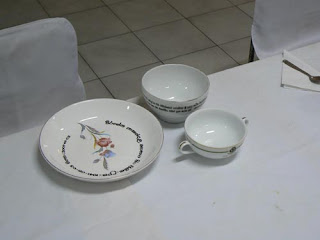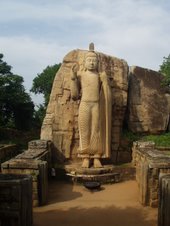It's a tradition of Kumudu's family to perform an annual pilgrimage to Kandy* and give dane at the Sri Dalida Maligawa (Sacred Temple of the Golden Tooth). The Sri Dalida Maligawa contains the Tooth Relic - reputably the molar of the Buddha. Worshipping at the Tooth Temple is particularly meritorious and confers a great deal of pin (positive karma). In accord with Buddhist doctrine, acting virtuously generates pin and therefore provides the conditions for a good rebirth. One way this can be achieved is through the action of giving or dane. Pilgrims to the Temple of the Tooth usually symbolically give dane to the tooth relic (which can only be described as a very large relic house designed in the shape of a chaitya around which is hung millions of dollars worth of gold, gems, diamonds etc - all donated by wealthy pilgrims). This symbolic gesture involves the pilgrims giving food and alms (a widely distributed package that includes a monks begging bowl, robe and fan). The same is also done for real monks which I will describe below.
My experience of the tooth, in a way, is unique, since few suddhas get to see the tooth relic closely. No photography of the relic is allowed, and most tourists are shuffled past a window in which they see the relic only for a moment. Because I was part of a group of pilgrims, I was allowed into the inner sanctum. The tooth, in this sense, is very secretively housed and is looked after by a group of specialist monks. Needless to say, the tooth relic is magnificent and is comparable with the crown jewels in terms of its opulence (of course, photos are not allowed). What is perhaps more interesting is the art work in the inner sanctum - it is perhaps the finest example of Theravadin Buddhist art that I have ever seen and is a shame that no one else gets to see it.
The inner sanctum is also of great historical significance. I noticed that a large part of the wall had broken away destroying some of the precious art it housed. When I asked about this I was told that this was due to an LTTE bomb that went off, causing some cosmetic damage to the Temple structure. Interestingly, however, the damaged parts only ended up revealing an even older set of art underneath that had been painted over. This, of course, was interpreted by the more nationalistic Buddhists as some kind of Sri Lankan revelation: The Buddha was protecting the Temple from the bomb blast and this was revealed through the appearance of this otherwise unknown art.

Worshipping the tooth is only part of the pilgrimage. Perhaps the main - and most difficult part - is the feeding the monks. Kumudu's family stayed up all night cooking food that was to be provided for the monks. Again, this act of giving is implicit within the Buddhist tradition and is derived originally from the practice of giving alms to wandering mendicant monks. Since then, Buddhism has become more systematized - monks have a wealth of food available to them and it would be unthinkable in a country like Sri Lanka for a monk to go hungry. For this reason I sometimes think that the intention behind the act of giving (dane) has become corrupt, i.e. merit is gained for helping others who cannot help themselves; it the idea of giving for its own sake. This intention is still somewhat preserved, however, through the action of giving meals to beggers on the streets (and they are very wretched beggers I might add). After the last puja I mentioned below, I gave a food package to a begger on behalf of my late grandmother (the idea being that I was donating the pin so that she would gain a good rebirth).
Temple of the Tooth - The monk looking at the camera took quite a liking to me and asked all sorts of questions concerning my interests in Buddhism (actually most monks take quite a liking on account that I am a foreigner and interested in Buddhism - obviously it doesn't take much to please monks. In fact many Sri Lankans seem to regard me as being "very religious" simply because I know Buddhist philosophy!). Sunsequently, he gave me a telephone number of a monk in Colombo that can teach me Pali - in fact I'd already arranged a course with a university in Keleniya.
The dane ceremony basically amounted to the principle monk (the fellow third from the left) giving bane (i.e. preaching). In this instance he talked - amongst other things - about the importance of marriage and blessed both of us! The monks at the Dalida Maligawa are a funny breed of monk in that they are generally quite learned and pious - in this sense they are usually quite a bit more serious looking than other monks (and this saying a lot since the main purpose of being a monk is to precisely to be serious). After the monk fishes preaching, the pilgrims go about giving out the food that had been prepared the night before. This involved us going around and spooning food into the monks bowls. In this instance, the monks seemed quite pious since few of them would take any kind of meat.
Some of the food we provided:

An example of the monks bowls and cutlery - notice that they are all quite plain (again part of the ascetic ideal), except for the writing (which simply states who the donor of the cutlery was therefore guarenteing that they get the appropriate merit - and social recognition. Many material gifts for monks have the name of the donor written on them. It is part of the technological mechanics of merit aquisition). Also note that the chairs upon which the monks sit is quite low (i.e. the legs are short): this is all part of the complicated monastic code which is designed to help the monks reduce desires.

Here is the Buddha statue in the monks eating quarters. This statue also receives alms prior to the dane. One interesting innovation which might represent a modern Hinduistic influence is the use of bright strobe lights behind Buddha statues. They usually represent the lights emitted from the Buddha when he attained enlightenment (although the colours are hardly comprehensive). I say it might be a Hindu influence only because such opulance is quite un-Buddhist like. But Sri Lankans are very competitive and would hate the idea that a Hindu deity lhas more bling than their own Buddha statues!

Going to all the trouble of visiting the hill country, seeing the golden tooth, preparing a veritable banquet of food and attending to the monks at the Dalida Maligawa all involves a huge amount of merit aquisition. Many families - including Kumudu's - do this once a year so that the merit they reap will guarentee a good future (although any belief that they will benefit before they die would be misplaced, and I happen to think that people believe this rather un-Buddhistic notion). One other thing about the tooth relic: although it is enclosed in the ritual casket described above, the tooth itself has gone on display at various times. Reputably, it is extremely large and looks rather like a yak tooth - but one shouldn't let that get in the way of a good mythological ideal!
*Although it is called Kandy, the proper Singhalese name is Nuwara. "Nuwara" simply means 'Town', so in a way it implies simply 'the town'. This probably is a throwback to when Kandy was the capital of the high country, prior to when the English captured it. That is, it really was the only big town that locals could go to hence it being simply called 'the town'. The name 'Kandy' is an English invention based upon the Singhala for hill 'kandha'. Nuwara was too complicated to say, and saying kandha with its unstressed '-dha' sound was also too difficult, so Kandy was invented, i.e. to denote that the city is in the heart of the hill country.






No comments:
Post a Comment